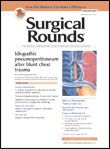Publication
Article
Surgical Rounds®
Case Volume Is a Poor Surrogate Marker for Laparoscopic Surgical Skills
Author(s):
Laparoscopically skilled surgeons with low case volumes have operative times, complication rates, and 30-day hospital readmission rates similar to high-volume surgeons.

Healthcare systems use an onerous credentialing process to ensure their surgeons are fully competent.
Most organizations check surgeons’ licensure status, training, and/or experience, which are indicators that can be documented with paper checks. However, they also verify competence, ability to provide particular services, and/or proficiency with particular procedures, which are more difficult to verify. As a result, many healthcare organizations use surgeon case volume as a surrogate for surgeon skill for credentialing purposes, which require establishing benchmarks for caseload.
The American Society of Colon and Rectal Surgeons (ASCRS) recommends that surgeons perform at least 20 laparoscopic colorectal resections with anastomosis for benign disease or metastatic colon cancer before performing laparoscopic resections for curable cancer — a recommendation that has been endorsed by the Society of American Gastrointestinal and Endoscopic Surgeons (SAGES).
For their retrospective cohort review published in the January 2014 issue of Surgical Endoscopy, researchers at Rush University Medical Center in Chicago, IL, compared surgeons with varying annual laparoscopic partial colectomy caseloads, examining objective outcome measures. Surgeons who performed fewer than 20 procedures before the study and fewer than 25 cases per year were classified as low volume (LV), while surgeons who exceeded those numbers were classified as high volume (HV).
The researchers found laparoscopically skilled LV surgeons had operative times, complication rates, lengths of stay, and 30-day readmission rates similar to HV surgeons. In fact, only median estimated blood loss was significantly different between the 2 groups, as patients with LV surgeons lost an average of 100 ml of blood, compared to 150 ml for those with HV surgeons. However, that difference had no clinical effect, as none of the patients needed a blood transfusion.
The authors noted surgeons with advanced laparoscopic training achieve similar outcomes regardless of their case volume. Thus, volume-outcome relationships may be poor surrogates in laparoscopic partial colectomy.






